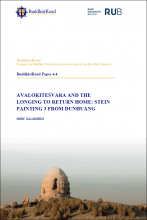BuddhistRoad Paper 4.4 "Avalokiteśvara and the Longing to Return Home: Stein Painting 3 from Dunhuang"
Synopsis
Stein painting 3 in the British Museum is a silk painting with a symmetrical composition of two Avalokiteśvara figures side by side. At 147.3×105.3 cm in size, this is one of the larger portable paintings from Dunhuang. At the top of the centre of the composition, between and above the heads of the two figures, is a yellow cartouche with a donor inscription. Although the inscription itself contains no date, it has been dated to the mid-9th century on the basis of a supposed reference to the Tibetan control of Dunhuang (787–848). This paper re-examines the inscription and argues that the part in question is unrelated to the Tibetan rule of the region and simply refers to a more generic situation of donors living away from their native land. By moving a detached piece of the silk to its original position, we can also possibly improve the reading of the inscription and, ultimately, its translation. A comparison with other similar inscriptions and colophons from Dunhuang demonstrates that the painting probably dates to the 920s, about seven decades later than previously assumed. In Dunhuang, this falls within the rule of the Guiyijun (851–1036?, 歸義軍, Return-to-Allegiance Army), when the region was separate from both Tibet and the Chinese states.
Chinese Translation
大英博物馆收藏的《斯坦因藏敦煌画作3》是一幅绢画,对称地描绘了两尊并排的观音像。这幅画的尺寸为147.3×105.3厘米,是敦煌出土的较大的便携式画作之一. 在画作中心的上部,两个人物头部上方的中间位置,有一个黄色小框,里面有供养人题记. 虽然题记本身没有日期,但根据对西藏控制敦煌(787–848年)时间的推测,它被断代为9世纪中期。本文对题记进行了重新研究,认为这部分内容与西藏对该地区的统治无关,只是涉及一种更为普遍的供养人远离故土的情况. 通过将脱落的绢块移回原位,我们或有可能修正对题记的誊录和翻译. 通过与敦煌其他类似的题记和跋文的比较,这幅画可能是公元920年代的作品,比之前的假设晚了近70年. 当时敦煌为归义军(851–1036?)统治时期,脱离了西藏和中原王朝的控制.

Downloads
Published
Categories
License

This work is licensed under a Creative Commons Attribution-NonCommercial-NoDerivatives 4.0 International License.

